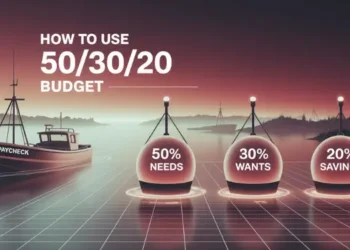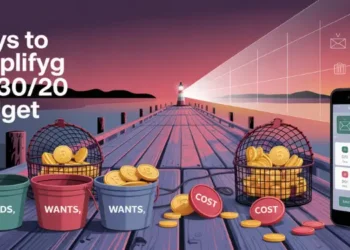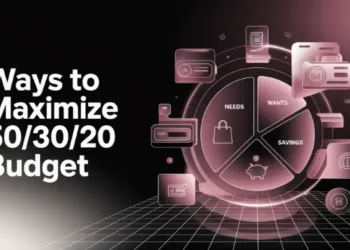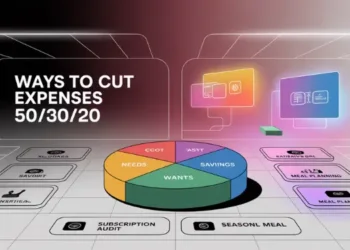Do Americans think a changing paycheck means constant worry? A big survey found many freelancers worry about monthly bills. But, success is possible.
The 2024 Freelancer Study reports that 62 % of independent workers feel anxious about covering monthly bills, and 41 % cite cash-flow gaps as their top stressor. More than half of U.S. workers now earn income outside a single job.
“Never depend on a single income,” Warren Buffett said. I once worried about rent when a check was late. That scared me into learning about Personal Finance & Investing.
This guide teaches how to manage variable income. It mixes Zero-Based Budgeting with smart tips for irregular income. We explore budgeting for variable income to avoid the stress of late checks. A proven financial strategy helps you build a steady safety net.
Freelancer income variability often leads to anxiety about covering fixed costs. A conservative baseline can be derived by averaging the three lowest pay periods over a defined timeframe. Zero-based budgeting allocates every dollar according to that baseline, with any surplus directed immediately into designated buffers or goal funds. Automating transfers for essential expenses, emergency reserves, tax obligations and retirement accounts ensures consistent allocation despite fluctuating receipts. Real-time cash-flow monitoring via dedicated budgeting tools supports early detection of shortfalls and prompts adjustments before critical deadlines.
Rolling category buffers capture excess revenue during peak periods and supply funds when income dips. Mid-cycle micro budgets recalibrate allocations as new payments arrive, maintaining alignment with baseline requirements. Seasonal trend analysis guides quarterly income assumptions, informing reserve targets and spending limits. Tax planning requires setting aside a fixed percentage per deposit to meet quarterly estimated-payment deadlines and adhering to retirement contribution limits. A buffer sized to the lowest expected paycheck held in a high-yield account reduces reliance on unpredictable cash flows and enhances financial resilience.
Here’s how it helps:
- Find a safe monthly amount to cover important bills.
- Use Zero-Based Budgeting for both good and bad times.
- Automate savings and create a safety fund for surprises.
- Keep track of budget changes so you’re always ready.
- Set aside a fixed % each month for quarterly estimated taxes and retirement contributions.
- Choose a budgeting app that supports real-time cash-flow alerts.
Calculate your reliable baseline using the three lowest pay periods
I once spent too much on new gadgets after a big paycheck. But then, my next paycheck was smaller. To avoid this, average the three smallest checks from the past year. This gives you a monthly income you can rely on.
This number helps you make a budget that works. Even if your income changes, this baseline keeps you steady. It reminds you that good months can turn bad, so stay ready.
Using the average of the three lowest income months offers a conservative baseline for variable budgets, reducing the risk of overcommitment in lean periods Ref.: “Upwork. (2025). How To Budget as a Freelancer: Practical Tips. Upwork Resources.” [!] Ref.: “Career Alley. (2025). 7 Smart Budgeting Tips Every Freelancer Should Know. CareerAlley.com.” [!]
Save extra money from good months. This money helps when times are tough. First, pay your bills, then save for emergencies or new goals. Remember, stable money means less stress.
Think about saving for a big goal, like a house. A simple average helps you plan without guessing. It keeps you calm through ups and downs.
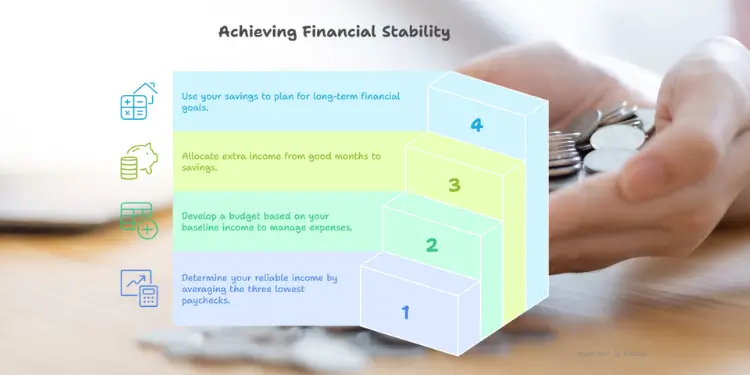
Baseline guards against overconfidence during boom months
Wondering how to keep spending in check during boom times? Your baseline serves as a safety net by covering only the expenses you can always afford, even when income falls. By matching your bills to that baseline and resisting the urge to splurge on larger paychecks, you maintain balance throughout the year and avoid surprises when work slows.
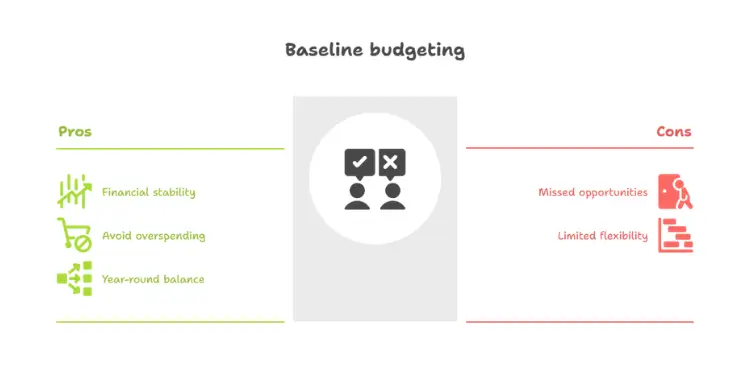
Send excess earnings to buffers and goal funds immediately
I learned the hard way that letting fresh funds sit in my checking invites random purchases. When you see extra money appear, direct it right away toward a targeted money goal or your emergency cushion.
Inject any surplus into your buffer the moment it clears. This step helps you manage your money before temptation strikes. You can create your budget with a margin of safety if demands shift.

I usually separate bills into needs and wants to see where I might scale back. This way to budget is flexible, because I can move surplus to a home improvement plan or launch a new fund for future dreams.
Overestimate your utility costs if it helps you stay prepared. Make adjustments as you track real usage. It’s wise to create a buffer that covers a shortfall if income dips. Sending that sum right away keeps me from spending it on impulse. This discipline protects both wants and needs.
Route surplus to an FDIC-insured high-yield savings account earning 4-5 % APY rather than leaving it idle.
Implementing automated transfers to buffer, tax, and retirement accounts requires selecting reliable banking or budgeting tools with automation features Ref.: “Wall Street Journal. (2025). Your Guide to Taxes for Self-Employed and Gig Workers. WSJ.com.” [!]
“Related Topics: 50/30/20 budget breakdown guide“
Use rolling categories that expand during high revenue stretches
I found a way to manage budgeting on an irregular income by using rolling categories. This method helped me when my income changed. When I made more money, I put extra in categories like utility or insurance.
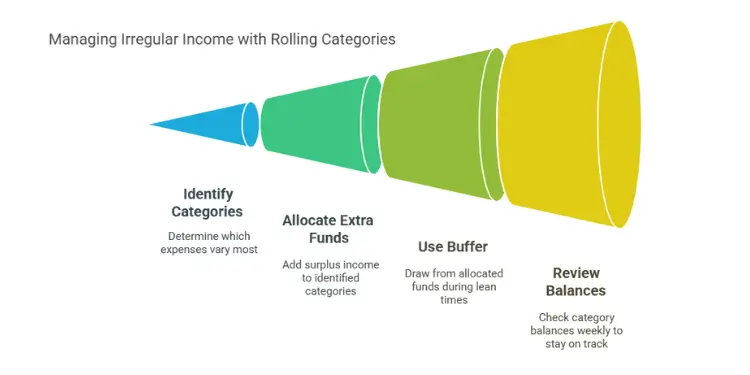
At times, I didn’t know how much I’d have to pay for essential expenses. Setting a steady baseline income goal helped. This way, I had a safety net for unexpected costs.
This method works best when you track each category with a new budget mindset. Some months, you add to a category. In lean times, you use it without worry. This keeps your finances healthy and worry-free.
Try these steps:
- Identify categories prone to major ups and downs.
- Pop extra funds into them during peak income.
- Rely on that buffer when revenue dips.
- Review balances each week to stay on target.
I often forget about small costs, so I focus on big allocations. Rolling categories help me stay ahead, not behind. This way, every dollar counts, even when my schedule is unpredictable.
Regular check-ins help avoid overspending. I review my budget every week. This ensures my rolling categories are balanced. It also helps me catch any unexpected costs. Rolling categories make budgeting flexible, keeping me calm no matter the income.
Apps such as Monarch Money and YNAB let you set rolling category caps and auto-sweep unspent balances.
“You Might Also Like: Best zero budgeting tools for hassle-free planning“
Run mid cycle micro budgets whenever new invoices clear
Freelance checks can come when you least expect them. Before they go, try a smart spending plan. I track each extra deposit and split it into clear categories. This helps me budget better and keeps me stable.
Having a budget helps you stay focused. If you need a budget, you can make one in minutes. Find a system or budgeting app that fits you. This helps avoid unexpected expenses and keeps your finances in check.
Saving a little each time you get paid helps. It covers small debts and fills your grocery fund. This method keeps your finances safe. You can also save for future goals. Check this guide for more tips on saving money.
Most digital banks now offer paycheck-splitting rules so new deposits flow directly into bills, savings, and tax buckets.
Quick micro plans keep cash directed not drifting
Making quick plans helps avoid random spending. Setting aside money for needs or future goals helps. This way, you stay focused, even when you get extra money.
“Related Articles: 50/30/20 vs pay yourself first comparison“
Review seasonal patterns to set smarter quarterly income assumptions
Watching for seasonal changes helps me get ready for times when my money might go up or down. I notice a big jump in summer, then a drop in January, which is often my lowest month. I keep my budget simple to stay on track.

I want to control my money, no matter what. Every time I get paid, I plan how to use that money. I use columns to track for saving or paying off debt. You might use ynab to see how much you have left for other goals.
Every quarter, I see patterns that help me plan better. I use these patterns to grow my savings or tackle big expenses. Here’s a simple example:
| Quarter | Potential Trend | Suggested Action |
|---|---|---|
| Q1 (Jan-Mar) | Post-holiday dip | Track every surge early and set some aside |
| Q2 (Apr-Jun) | Spring boost | Reinvest extra funds or build an emergency reserve |
| Q3 (Jul-Sep) | Steady revenue | Maintain normal spending habits and refine future plans |
| Q4 (Oct-Dec) | Holiday surge | Use surplus for major bills or bigger savings goals |
Plan taxes and retirement around 2025 deadlines
Freelancers pay their own Social Security and Medicare through self-employment tax (currently 15.3 % on net earnings) and must send quarterly estimated payments to the IRS if they expect to owe at least $1,000 for the year. The standard deadlines for the 2025 tax year appear below.
According to the IRS 2025 tax calendar, quarterly estimated-tax payments are due on the dates below.
| Quarter | Income period | Payment due date |
|---|---|---|
| Q1 | Jan 1 – Mar 31 | April 15 2025 |
| Q2 | Apr 1 – May 31 | June 16 2025 |
| Q3 | Jun 1 – Aug 31 | September 15 2025 |
| Q4 | Sep 1 – Dec 31 | January 15 2026 |
Set aside a fixed percentage of every deposit for taxes (Form 1040-ES gives the worksheet) and review the rate each January when the IRS publishes new thresholds.
Retirement contributions are another line-item in a variable-income budget. For 2025 the main limits are:
- Solo 401(k): Employee deferral up to $23,500 plus employer profit-sharing for a combined cap of $70,000 (or $76,500 if age 50+ with the $7,500 catch-up).
- SEP-IRA: Lesser of 25 % of net earnings or $70,000 for 2025.
Automate transfers to these accounts whenever income exceeds your baseline, and revisit contribution targets whenever tax law or IRS cost-of-living adjustments change. A recent Wall Street Journal tax guide for independent workers recommends checking limits each November so you can max out before year-end.
“Read More: How to do zero budgeting with clear examples“
Build a buffer account sized to your lowest expected paycheck
One late client payment once left me scrambling for rent—a sharp reminder that living invoice-to-invoice is risky. Use your leanest income month as the trigger amount for a starter cushion.
Begin by saving the cash equivalent of that lowest paycheck, then build toward three-to-six months of essential expenses. Keep the buffer in a separate high-yield savings account (top online rates are hovering around 5 % APY) so the money earns while it waits.
Allocating substantial earnings to a high-yield savings buffer enhances stability yet may limit opportunities for higher-yield investments Ref.: “Nevins, S., & Benninger, M. (2024). Pros And Cons Of High-Yield Savings Accounts. Forbes Advisor.” [!]
Whenever income exceeds your baseline, sweep the surplus directly into the buffer before it reaches your spending account. Automating this transfer removes temptation and lets compound interest do its work.
Review the balance weekly and adjust targets as costs change. Some freelancers rest easy with one month of bills banked; others aim higher. Even $5 a day grows to $1,825 a year—enough to handle a surprise car repair or delayed invoice.



